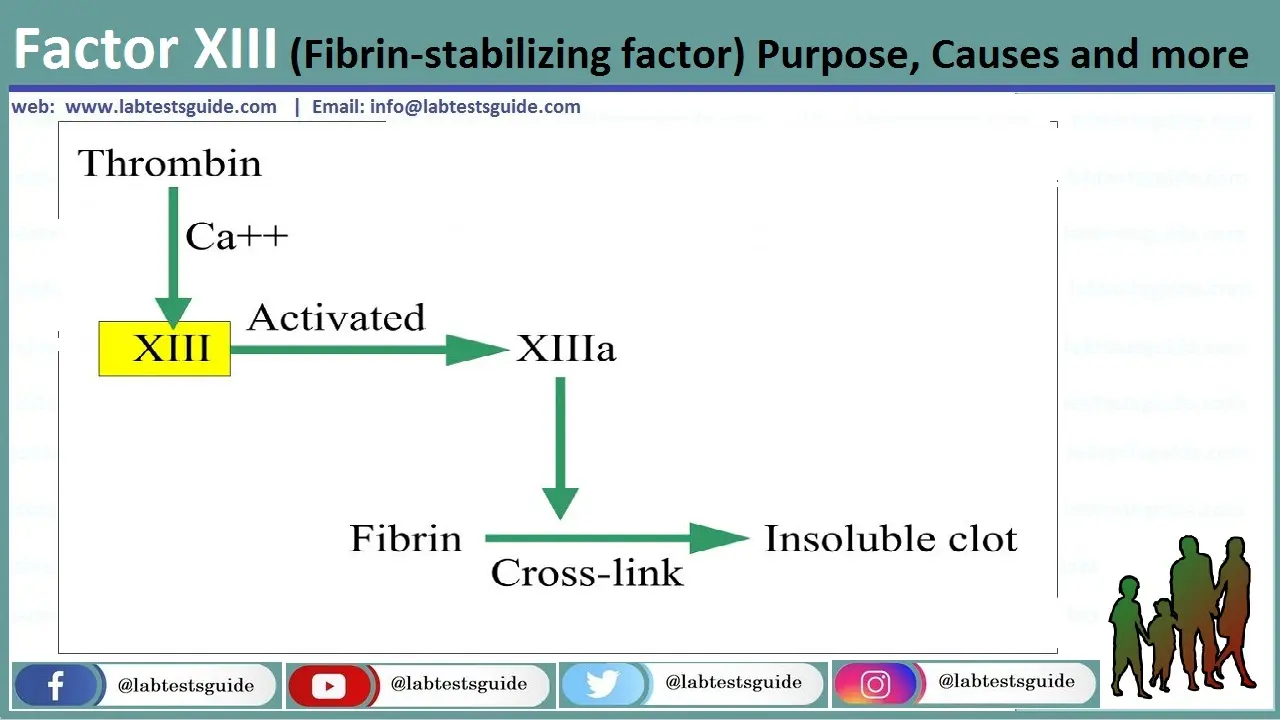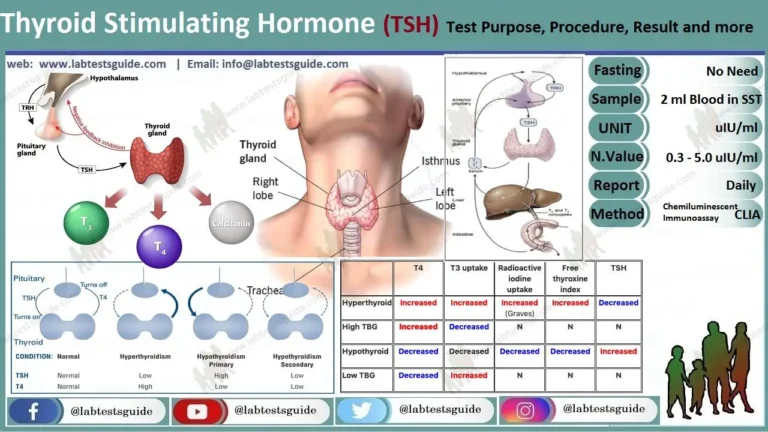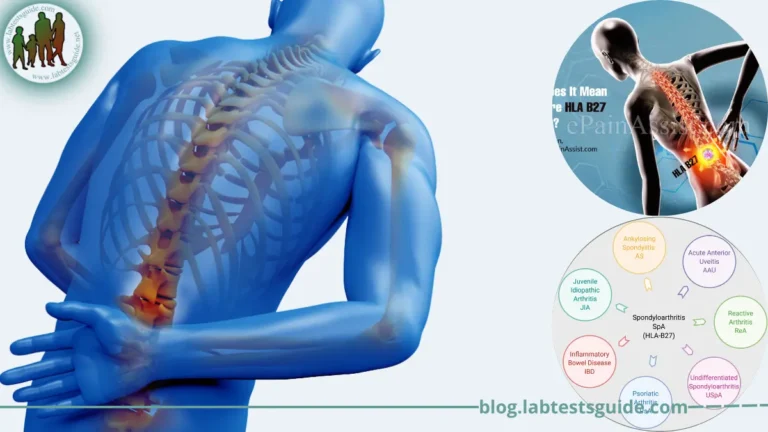Factor XIII or fibrin stabilizing factor is a zymogen found in the blood of humans and other animals. It is activated by thrombin to factor XIIIa. XIIIa is an enzyme in the blood clotting system that crosslinks fibrin. XIII deficiency worsens the stability of the clot and increases the tendency for bleeding.

Also Known as: Coagulation Fators, Factor Assays, Blood Clotting Factors, Clotting Factors, Factor I, Factor II, Factor III,Factor IV, Factor V, Factor VI, Factor VII, Factor VIII, Factor IX, Factor X, Factor XI, Factor XII,Factor XIII
Related Tests: Prothrombin Time (PT), Partial Thromboplastin Time (PTT), Fibrinogen, Activated Partial Thromboplastin Time (APTT)
Why Get Tested:
- To measure the coagulation factor concentration in the blood.
- To find the inherited or acquired bleeding disorders.
- If there is a history of bruises or excessive bleeding.
- If there are prolonged PT or PTT.
- Acquired conditions like Vit. K deficiency or liver disease.
- Maybe advised to monitor the treatment of a patient with factor deficiency.
When to get Tested:
- When you have unexplained or prolonged bleeding
- When you have abnormal coagulation screening tests, such as prothrombin time (PT) or partial thromboplastin time (PTT)
- When you have a family member with a hereditary coagulation factor deficiency
- You may have a test when your healthcare professional wants to control the severity of a factor deficiency and / or the effectiveness of the treatment.
Signs And Symptoms Of XIII Deficiency:
- There is easy bruising and soft tissue bleeding which may be due to trauma.
- There may be a severe bleeding tendency.
- The bleeding tendency may be like hemophilic patients, these patients may have hemarthrosis and deep tissue bleeding.
- This bleeding is characterized by the initial stoppage of bleeding followed by the recurrence of the bleeding after the 36 hours or more after the initial trauma.
- This result from the dissolution of the fibrin clot that formed in the beginning and was not stabilized by the factor XIII.
- Acquired partial deficiency has been reported with few diseases like leukemia, DIC, and severe liver disease.
- There is a possibility of spontaneous miscarriage in early pregnancy.
- There may be bleeding from the umbilical cord which may be from 1 to 9 days of birth.
- There may be CNS hemorrhage which is quite common. This may be the first symptom.
- The patient with CNS hemorrhage may have a headache, vomiting, seizures, and focal neurologic defects.
- These patients may have intra-abdominal bleeding during menses.
- There will be bleeding into the joints (hemarthrosis).
- There is poor wound healing.
Sample Required:
- The plasma is needed, take 5 ml of venous blood and add sodium citrate as the anticoagulant.
- Perform the assay immediately or as soon as possible.
- For factors II, V, VII, and X, place the citrated plasma on ice immediately, and the sample is stable for 2 hours.
- Freeze if it is delayed >2 hours.
Test Preparation Needed
No need any Preparation for this sample.
Lab diagnosis:
- PT, APTT, fibrinogen, bleeding time, and platelet count are normal.
- The clot is soluble in 5 Molar urea solution.
Normal
- Plasma concentration = 2.5 mg/dl.
List of factors:
The table lists 13 of 20 different coagulation factors involved in the coagulation cascade that are vital to normal blood clotting.
| Coagulation Factor | Other Common Name |
|---|---|
| Factor I | Fibrinogen |
| Facto II | Prothrombin |
| Factor III | Tissue factor or thromboplastin |
| Factor IV | Calcium |
| Factor V | Proaccelerin (Labile factor) |
| Factor VI | Unassigned – old name of Factor Va |
| Factor VII | Proconvertin (Stable factor) |
| Factor VIII | Antihaemophilic factor A, Antihaemophilic globulin |
| Factor IX | Antihaemophilic factor B, Plasma thromboplastin component, Christmas factor |
| Factor X | Stuart-Prower factor |
| Factor XI | Plasma thromboplastin antecedent, Haemophilia C, Rosenthal syndrome |
| Factor XII | Hageman factor |
| Factor XIII | Fibrin stabilising factor, Laki-Lorand factor |
Normal Values:
| Factors | Normal Values |
|---|---|
| Factor I (Fibrinogen) | Adult = 200 to 400 mg/dLNewborn = 125 to 300 mg/dL |
| Factor II (Prothrombin) | 10 to 15 mg/dL |
| Factor III (Thromboplastin) | |
| Factor IV (Ionized calcium) | 4.60 to 5.08 mg/dL |
| Factor V (Labile Factor) | 5 to 10 mg/dL |
| Factor VI | Not existing |
| Factor VII (Stable factor) | 5 to 20 mg/dL |
| Factor VIII (Antihemophilic factor) | 30 mg/dL |
| Factor IX (Christmas factor) | 30 mg/dL |
| Factor X (Stuart factor) | 8 to 10 mg/dL |
| Factor XI (Plasma thromboplastin) | 25 mg/dL |
| Factor XII (Hageman factor) | |
| Factor XIII (Fibrin-stabilizing factor) | |
| Von Willebrand factor |
Diseases Leading To Coagulation Factor Deficiency:
| Disease | Factor deficiency |
|---|---|
| Disseminated intravascular coagulopathy | I, V, VIII |
| Liver diseases | I, II, V, VII, IX, X, XI |
| Autoimmune diseases | VIII |
| Congenital deficiency | I, II, V, VII, VIII, IX, X, XI, XII |
| Vit K deficiency | II, VII, IX, X, XI |
| Heparin therapy | II |
| Warfarin therapy | II, VII, IX, X, XI |
| Fibrinolysis | I, V, VIII |
Treatment
- The following blood substitutes can be tried.
- Fresh frozen plasma.
- Cryoprecipitate.
- Factor XIII concentrate.
- Factor XIII recombinants.
Possible References Used






